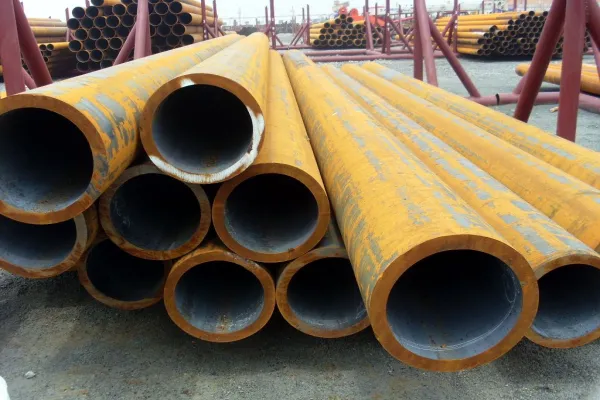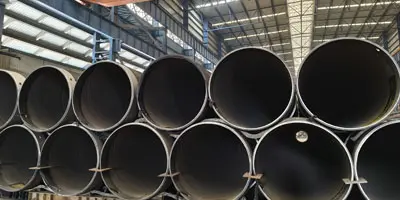What are boiler tubes?
Boiler tubes are made from carbon steel or alloy steel and can withstand high pressures and temperatures. Boiler tubes are seamless and come in two types: medium pressure and high pressure, depending on the intended use. Boiler tubes are important to many industries, especially steam boilers, power plants, and factories.
Boiler tubes are made with great care to ensure they are strong and reliable. Let's take a closer look at how they are made. Material selection Seamless boiler tubes are a key factor in ensuring safe and efficient operation of boilers. Given the demanding operating conditions inside a boiler, the material must meet stringent performance requirements. Therefore,
seamless boiler tubes are usually made from high-quality carbon steel, alloy steel, or stainless steel. The service life of seamless boiler tubes depends on various factors such as material type, operating environment, and maintenance, but they typically last more than 10 years.
Commonly used materials for high-pressure boiler tubes
At present, steel high-pressure boilers have been widely used in petrochemical, machinery, metallurgy, energy, light industry, national defense, environmental protection, ocean, space, life and other industrial sectors and scientific research fields. The specifications are Ф10~1064mm and above. Many enterprises have the production capacity of high-pressure boiler tubes. The steel types they use are also very high, including high-quality carbon steel 20G, manganese steel SA-106C, SA-210C, copper steel 15Mo3, SA-209T1a, chrome-molybdenum steel SA-213T2, 15CrMoG, SA-213T22, chrome-molybdenum-vanadium steel 12Cr1MoVG, 12Cr2MoWVTiB (steel 102), SA-213T91, chrome-nickel steel SA-213TP304H, SA-213TP347H and other materials.
Commonly used high-quality carbon steel (10, 20), alloy steel (12crmo, 15crmo), heat-resistant steel (12cr2mo, 15cr5mo), stainless steel (1cr18ni9, 1cr18ni9ti) are used for manufacturing. In addition to the chemical composition and various mechanical properties of steel pipes, water pressure, flattening, expansion and other tests, as well as surface quality and non-destructive testing must be guaranteed.
Materials: 20G, 20MnG, 25MnG, 15MoG, 20MoG, 12CrMoG, 15CrMoG, 12Cr2MoG, 12CrMoVG, 12Cr3MoVSiTiB, 1Cr18Ni9, 1Cr18Ni11Nb
Boiler tube material requirements:
The materials used for boiler tubes must be carefully selected to meet the following requirements:
(1) High temperature resistance and high strength
High-pressure boiler tubes are often in high temperature and high pressure conditions during use. Under the action of high-temperature flue gas and water vapor, the pipes will oxidize and corrode. The steel pipes are required to have high lasting strength, high oxidation resistance, corrosion resistance and good structural stability. The working conditions of high-pressure boiler tubes are very harsh. They must work safely for 10 to 20 years or even longer under high pressure, high temperature and high-speed air flow, water flow and coal gas erosion and corrosion.
(2) Thermal conductivity
Boiler tubes, especially high-pressure boiler tubes, are pipes for transporting high-temperature and high-pressure steam or hot water, and play an important role. In the design and use of high-temperature boiler tubes, thermal conductivity is a very critical indicator.
Heat conduction is the process of heat transfer from a high-temperature object to a low-temperature object. In high-temperature boiler pipes, heat conduction is mainly conducted through the tube wall. The thermal conductivity of the tube wall is related to the thermal conductivity, wall thickness, tube diameter, temperature gradient, etc. of the material.
Materials Commonly Used for Boiler Tubes
The selection of materials for boiler tubes depends largely on the operating conditions inside the boiler, including temperature, pressure, and the potential for corrosion. Here are the most commonly used materials for manufacturing high-pressure and medium-pressure boiler tubes:
1. Carbon Steel
Carbon steel is one of the most widely used materials for medium-pressure boiler tubes. It provides excellent mechanical strength and is relatively cost-effective. The most common types of carbon steel used for boiler tubes are:
20G: Often used for low and medium-pressure boilers, 20G is a high-quality carbon steel with a good balance of strength and thermal conductivity.
20MnG and 25MnG: These grades offer increased tensile strength and are suitable for applications involving slightly higher pressures.
2. Alloy Steel
Alloy steel is essential for high-pressure and high-temperature applications. Alloying elements such as chromium, molybdenum, and vanadium are added to improve heat resistance, strength, and corrosion resistance. Commonly used alloy steels include:
12Cr1MoVG: A chromium-molybdenum-vanadium steel that offers excellent high-temperature performance, often used in superheaters and reheaters of high-pressure boilers.
15CrMoG: This material is known for its resistance to oxidation and corrosion, making it suitable for high-pressure applications where both thermal stability and resistance to erosion are important.
12Cr2MoG: Another chromium-molybdenum alloy, providing enhanced resistance to high-temperature oxidation and pressure.
3. Heat-Resistant Steel
For applications requiring exceptional heat resistance, heat-resistant steel is used in high-temperature boilers. These steels are designed to maintain strength and resist oxidation under extreme conditions:
12Cr2Mo: Known for its excellent heat resistance, this steel is typically used in medium-pressure to high-pressure boilers where temperatures can reach up to 450°C.
15Cr5Mo: This material offers improved high-temperature strength and is often used in environments with severe temperature fluctuations.
4. Stainless Steel
Stainless steel is selected for its superior corrosion resistance, especially in environments prone to moisture or chemical exposure. It is commonly used for high-pressure applications and in situations requiring high resistance to corrosive media. Common grades of stainless steel for boiler tubes include:
1Cr18Ni9: Austenitic stainless steel with good corrosion resistance and strength at elevated temperatures, suitable for high-temperature steam environments.
1Cr18Ni9Ti: This variant includes titanium, improving the material's resistance to heat and corrosion, often used in environments with aggressive chemical exposure.

Boiler Tube Materials Standards & Specifications
|
Material Type
|
Standards
|
Common Sizes
|
Types
|
|
Carbon Steel
|
ASTM/ASME A/SA 106, ASTM A179, ASTM A192, ASTM/ASME A/SA 210, ASTM A333 Gr 1, 6, 7 to Gr 9
|
OD: 6mm to 1240mm, Thickness: 1mm to 50mm
|
Straight boiler pipe, U boiler steel pipe for tube exchanger bundle
|
|
Alloy Steel
|
ASTM/ASME A/SA 213 T1, T2, T5, T9, T11, T12, T22, T91, T92; ASTM A335 P1, P2, P5, P9, P11, P12, P22, P91, P92
|
OD: 6mm to 1240mm, Thickness: 1mm to 50mm
|
Straight boiler pipe, U boiler steel pipe for tube exchanger bundle
|
|
Stainless Steel
|
ASTM A268, ASTM A213, TP304/L, TP316/L, 310S, 309S, 317, 317L, 321, 321H, Duplex Stainless Steel
|
OD: 6mm to 1240mm, Thickness: 1mm to 50mm
|
Straight boiler pipe, U boiler steel pipe for tube exchanger bundle
|
|
Attribute
|
Carbon Steel Boiler Tubes
|
Stainless Steel Boiler Tubes
|
Alloy Steel Boiler Tubes
|
|
Chemical Composition
|
Iron and carbon, low carbon content (<0.35%)
|
At least 10.5% chromium, often with nickel, molybdenum
|
Iron, carbon, and various alloying elements (e.g., manganese, silicon, chromium, nickel)
|
|
Mechanical Properties
|
Lower strength and hardness
|
Good formability; moderate strength
|
Higher strength, toughness, and wear resistance
|
|
Corrosion Resistance
|
Low; may need coatings or linings
|
High due to chromium oxide layer
|
Good to excellent, depending on alloying elements
|
|
Applications
|
General-purpose, low to moderate temperature and pressure
|
Corrosive environments, food processing, chemical industry
|
High-temperature and high-pressure applications, such as in power stations
|
|
Cost and Economy
|
Lower initial cost; may require more maintenance
|
Higher initial cost; potentially lower lifecycle cost
|
Varies; can be more expensive due to alloy content
|
|
Environmental Impact and Sustainability
|
Regular maintenance may be needed
|
Recyclable; low maintenance
|
Varies; some alloys are highly recyclable
|
|
Lifespan
|
Shorter lifespan if not properly protected against corrosion
|
Longer lifespan due to self-healing properties and corrosion resistance
|
Long lifespan, especially in harsh environments; depends on alloy composition
|
Boiler tube components and materials used:
|
Boiler Component
|
Function Description
|
Typical Material Used
|
|
Water Wall Tubes
|
Main heat-receiving surface around the furnace.
|
Carbon Steel
|
|
Convection Tubes
|
Further heating of fluid in the convection area of the boiler.
|
Carbon Steel or Alloy Steel
|
|
Downcomer Tubes
|
Transport water from the steam drum to the downcomer.
|
Carbon Steel
|
|
Header (Collector)
|
Collects and distributes boiler water; not typically exposed to radiant heat.
|
Carbon Steel or Stainless Steel
|
|
Superheater Tubes
|
Heat saturated steam into superheated steam, improving steam quality.
|
Alloy Steel
|
|
Economizer Tubes
|
Use residual heat from exhaust gases to raise feedwater temperature.
|
Carbon Steel or Alloy Steel
|
Applications of Different Boiler Tube Materials
Classification of high-pressure boiler tube uses: used for heating surface tubes of low and medium pressure boilers (working pressure is generally not more than 5.88Mpa, working temperature is below 450℃); used for heating surface tubes, economizers, superheaters, reheaters, petrochemical industry tubes, etc. of high-pressure boilers (working pressure is generally above 9.8Mpa, working temperature is between 450℃ and 650℃).
According to the composition materials, it can be divided into 20G high-pressure boiler tube, 12Cr1MoVG high-pressure boiler tube, Gangyan 102 high-pressure boiler tube, 15CrMoG high-pressure boiler tube, 5310 high-pressure boiler tube, 3087 low and medium-pressure boiler tube, 40Cr high-pressure boiler tube, 1Cr5Mo high-pressure boiler tube, 42CrMo high-pressure boiler tube. For low pressure with low pressure, 20G is generally used. 20G, which is a kind of material in Q245R steel, belongs to boiler plate. g is the first letter of "pot" in boiler plate: g. Implementation standard: GB713-1997 (internal and external standards implement this standard) Scope of application: steel plates with a thickness of 6mm-150mm.
Because the steel plate is delivered with positive tolerance, the boiler plate also has a thickness additional value table. When calculating the weight of the steel plate theoretically, it is necessary to add the corresponding value in the table on the basis of the thickness. According to the requirements, the steel plate can be delivered after heat treatment: controlled rolling, normalizing, etc. The flaw detection standard is implemented as follows: JB/T4730.3-2005, divided into three levels.






 English
English Español
Español بالعربية
بالعربية











 Phone :
Phone :  Whatsapp :
Whatsapp :  Email :
Email : 


